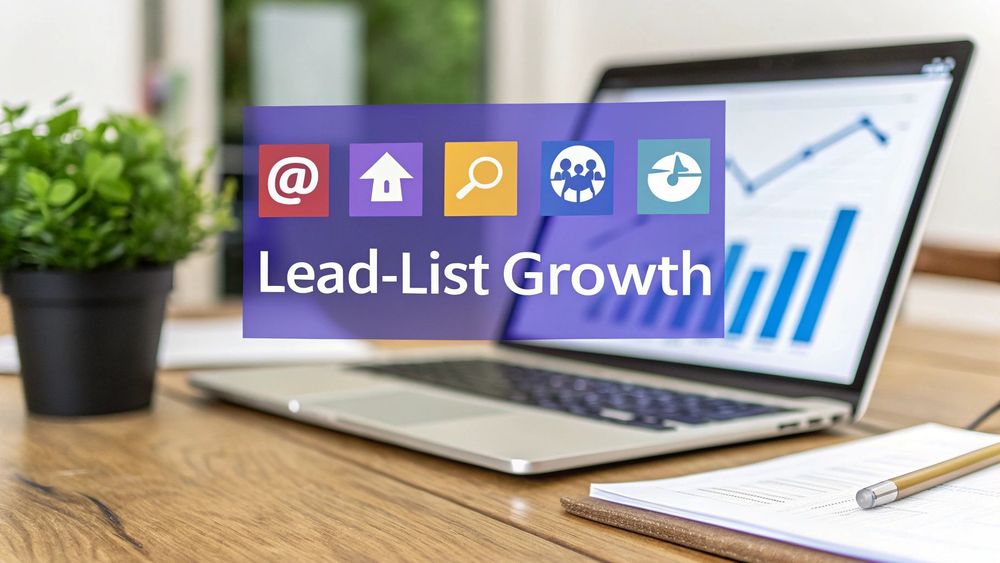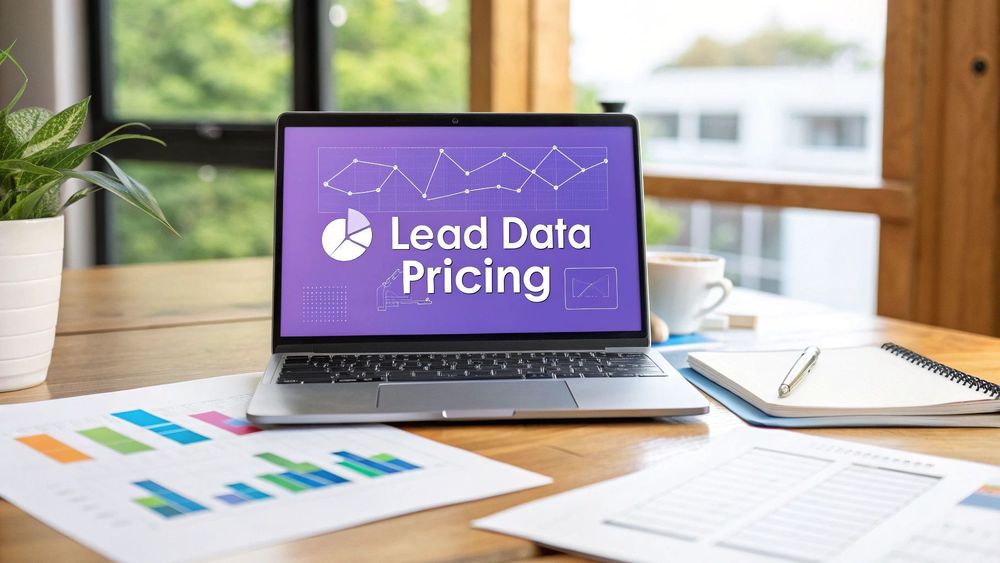So, you’ve built a solid list of contacts. Maybe you used a slick, no-code tool like ProfileSpider to perform one-click AI profile extractions from LinkedIn or another website. That’s a great start.
But a list of names and companies is just potential energy. It's a starting point, not the finish line. The real magic happens when you turn that static data into a dynamic engine for sales, marketing, or recruitment. This guide will show you how.
From Raw Data to Real Opportunities
This playbook isn’t about abstract theory. It’s for the modern sales pro, marketer, and recruiter who needs to get things done. We're jumping straight into the practical, actionable steps to take your raw lead list and turn it into a revenue-generating machine.
The traditional way of doing this involves tedious manual research—copying and pasting names, job titles, and company details one by one. It’s a slow, error-prone process that drains hours of productive time.
The modern workflow, powered by ProfileSpider, simplifies this entire process. It’s about collecting the right data with a single click, enriching it automatically, and then engaging with it in a meaningful way. Each stage builds on the last, creating a solid foundation for outreach that actually gets results.
This visual flow breaks down the basic journey of marketing your lead list:
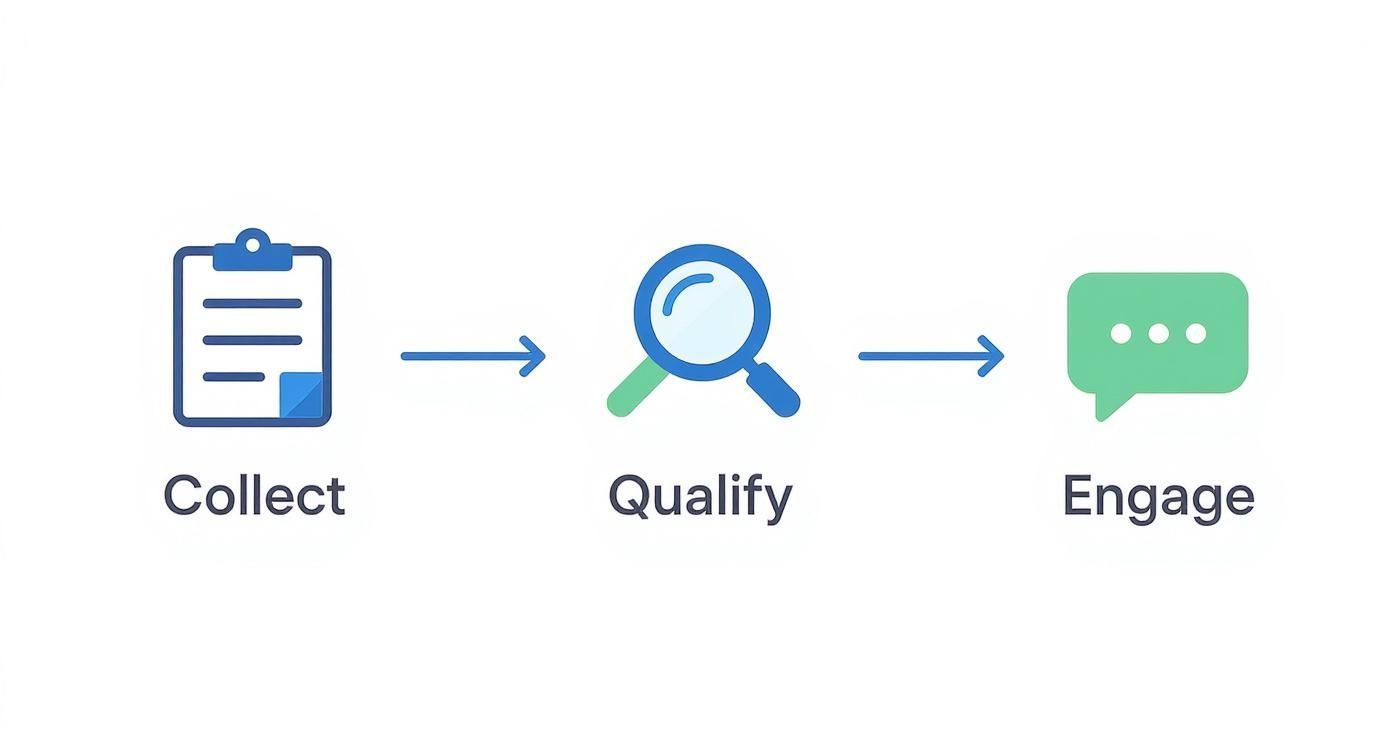
As you can see, success isn't just about grabbing data. It’s about systematically refining and acting on that data to start real conversations.
Think of your lead list as a living asset, not a one-and-done project. A well-maintained and thoughtfully marketed database is one of the most valuable resources you can have. It's the starting point for every relationship you build, every bit of interest you nurture, and ultimately, every deal you close.
A curated lead list is more than just data; it's a map of your future customers. The goal is to move from a generic pile of contacts to a targeted collection of high-potential accounts that align perfectly with your ideal customer profile.
Before we dive deep into the specific tactics, let's establish the foundational pillars that support any successful lead list marketing strategy. These are the non-negotiable stages that transform a simple contact sheet into a strategic asset.
Lead List Marketing Core Pillars
| Pillar | Objective | Key Activities |
|---|---|---|
| Cleaning & Enrichment | Ensure data accuracy and completeness. | Verify emails, remove duplicates, add missing data points (e.g., job titles, company size). |
| Segmentation | Group contacts for targeted messaging. | Segment by industry, role, location, company size, or technology used. |
| Multi-Channel Outreach | Engage prospects where they are active. | Select and execute campaigns across email, LinkedIn, ads, and cold outreach channels. |
| Personalization at Scale | Create relevant, compelling messages. | Use dynamic fields, custom snippets, and tiered personalization based on account value. |
| Automation & Tooling | Streamline repetitive tasks and scale efforts. | Implement CRMs, outreach tools, and workflows to manage campaigns efficiently. |
| Tracking & Iteration | Measure performance and optimize your strategy. | Monitor KPIs like open rates, reply rates, and conversion rates to refine your approach. |
This framework provides a clear roadmap. Each pillar is a critical step in building a system that consistently generates opportunities.
In the sections that follow, we'll break down each of these phases. We'll give you the tools, templates, and techniques you need to turn every single name on your list into a genuine business opportunity. Let's get started.
It All Starts with High-Quality Data
Before you even think about writing a subject line or crafting a cold call script, the fate of your campaign is already being decided. By what? The quality of your lead list.
It’s a hard truth, but even the most brilliant message is useless if it’s sent to the wrong person, a dead email address, or addressed to "Fname Lname." A list riddled with outdated info, typos, and missing details is a one-way ticket to terrible deliverability, wasted hours, and abysmal results.
So, the first step isn't about the pitch. It’s about building a rock-solid data foundation. This boils down to two critical activities: cleaning and enrichment.
The Essential Data Health Check
First things first, you need to clean up the raw data you've gathered. This isn't just about deleting a few bad entries; it’s a systematic overhaul to improve the health of your entire list. A clean list is your best defense against high bounce rates, embarrassing personalization mistakes, and your team chasing ghosts.
Think of it as a basic health check. Here’s what you absolutely have to do:
- Zap Duplicates: Whether you’re merging lists from a trade show and a web scrape or just doing some spring cleaning, duplicates are a given. Finding and merging them is crucial. Nothing screams "amateur" louder than contacting the same person twice in one campaign.
- Standardize Everything: "VP of Sales," "Sales Vice President," "VP, Sales"... it's all the same, but to a machine, they're different. You need to standardize job titles, company names (think "Acme Inc." vs. "Acme Corporation"), and locations to create a clean, uniform dataset that’s actually usable for segmentation.
- Validate Emails (Seriously): High bounce rates can absolutely tank your domain's sending reputation, landing all your future emails in spam folders. Use an email validation service to check for typos, confirm the domain is real, and make sure the inbox is active. This is non-negotiable.
While many CRMs have tools for this, you'd be surprised what a quick manual scan in a spreadsheet can catch. This initial cleanup is your first line of defense.
From Good Data to Great Data with Enrichment
Okay, your list is clean. Now it's time to make it powerful. This is where enrichment comes in.
Enrichment is the process of taking a basic contact list and turning it into a strategic goldmine. You’re adding crucial context that allows for truly personal—and effective—outreach.
A raw scraped list might just give you a name and a company. An enriched list, on the other hand, tells a story. It could include:
- Job Title and Seniority
- Company Size and Industry
- Direct-dial Phone Number
- LinkedIn Profile URL
- Their City and State
Trying to find all of this manually is a soul-crushing exercise in copy-pasting. For a list of just a few hundred contacts, you could easily lose days of your life to this.
The Modern Workflow: This is exactly why tools like ProfileSpider exist. Instead of spending hours on manual research, you use the one-click “Enrich” feature. ProfileSpider automatically visits the profile URLs in your list, and its AI-powered engine extracts all those missing details for you—job titles, social links, contact info, and more.
This transforms a tedious, multi-day chore into a simple, scalable action. For a sales rep, this is the difference between a generic "Hope you're well" and a targeted "Saw you're the VP of Sales at a 200-person tech company..." For a recruiter, it means getting a candidate's full professional story without hours of digital stalking.
By combining meticulous cleaning with smart enrichment, you're not just doing admin work. You're laying the strategic groundwork for everything that follows. A clean, rich, and accurate list ensures your message actually arrives, resonates, and ultimately drives the results you’re after.
Segmenting Your List for Personalized Outreach

Sending a generic, one-size-fits-all message to your entire lead list is the fastest way to get your emails ignored, deleted, or flagged as spam. Effective outreach isn't about sheer volume; it's about hitting the right person with the right message.
This is where smart segmentation comes in. It's the art of turning a massive, impersonal list of contacts into smaller, hyper-relevant groups. The goal is to make every single person feel like you're speaking directly to them. When your message speaks to their specific role, industry, or challenges, it stops feeling like a sales pitch and starts feeling like a genuine conversation.
Going Deeper Than Just Demographics
Forget basic segmentation by location or company name. To really make an impact, you need to dig deeper into the data you've already collected. Advanced segmentation is what allows you to craft messages with surgical precision.
This is where all that hard work during the data collection and enrichment phases pays off. Tools like ProfileSpider don't just hand you a name and an email; they provide the rich, contextual data you need to create powerful segments.
Here are a few ways to slice up your list that go beyond the basics:
- Firmographics: Group leads by company size, industry, or annual revenue. A 10-person startup has completely different pain points than a Fortune 500 company.
- Technographics: Segment your list based on the software stack they already use. Are they a HubSpot shop? Do they run on Salesforce? This intel lets you position your product as the perfect integration or a superior alternative.
- Behavioral Data: Group leads by their actions. Did they download a specific whitepaper? Have they visited your pricing page three times this week? These are buying signals.
- Job Role & Seniority: A CTO isn't worried about the same things as a junior developer. Segmenting by job title ensures your message lands with the right person, addressing their specific priorities.
How This Looks in the Real World
Let's make this tangible. Imagine you are a sales professional selling a B2B SaaS product. Using data from ProfileSpider, you could build a segment of "VPs of Marketing at tech companies with 50-200 employees." Suddenly, your outreach can talk about the specific growth challenges that companies of that exact size and type face. It’s instantly more compelling.
Or, if you're a recruiter, you can create a hyper-specific list of "Software Engineers with 5+ years of Python experience in Austin, TX." That kind of targeted outreach gets noticed. ProfileSpider's smart organization features, like custom lists and tags, make creating and managing these segments effortless.
Segmentation is the bridge between having data and using it wisely. It turns a generic blast into a strategic, multi-pronged attack where every message hits its mark because it was designed for a specific audience.
The Financial Side of Smart Segmentation
Let’s be clear: getting this right has a real impact on the bottom line. The global lead generation market is on track to hit $21.43 billion by 2033, all driven by the need for better targeting.
The numbers don't lie. While organizations generate an average of 1,877 leads per month, the cost per lead (CPL) can range from $91 in e-commerce to a staggering $982 in higher education. This tells you that success isn't just about getting more leads; it's about the efficiency and precision that good segmentation delivers.
Ultimately, breaking your list into smaller, more relevant groups is the key to cutting through the noise. It makes your outreach feel personal, solves real problems, and dramatically increases your chances of getting a reply.
Crafting Multi-Channel Outreach Campaigns
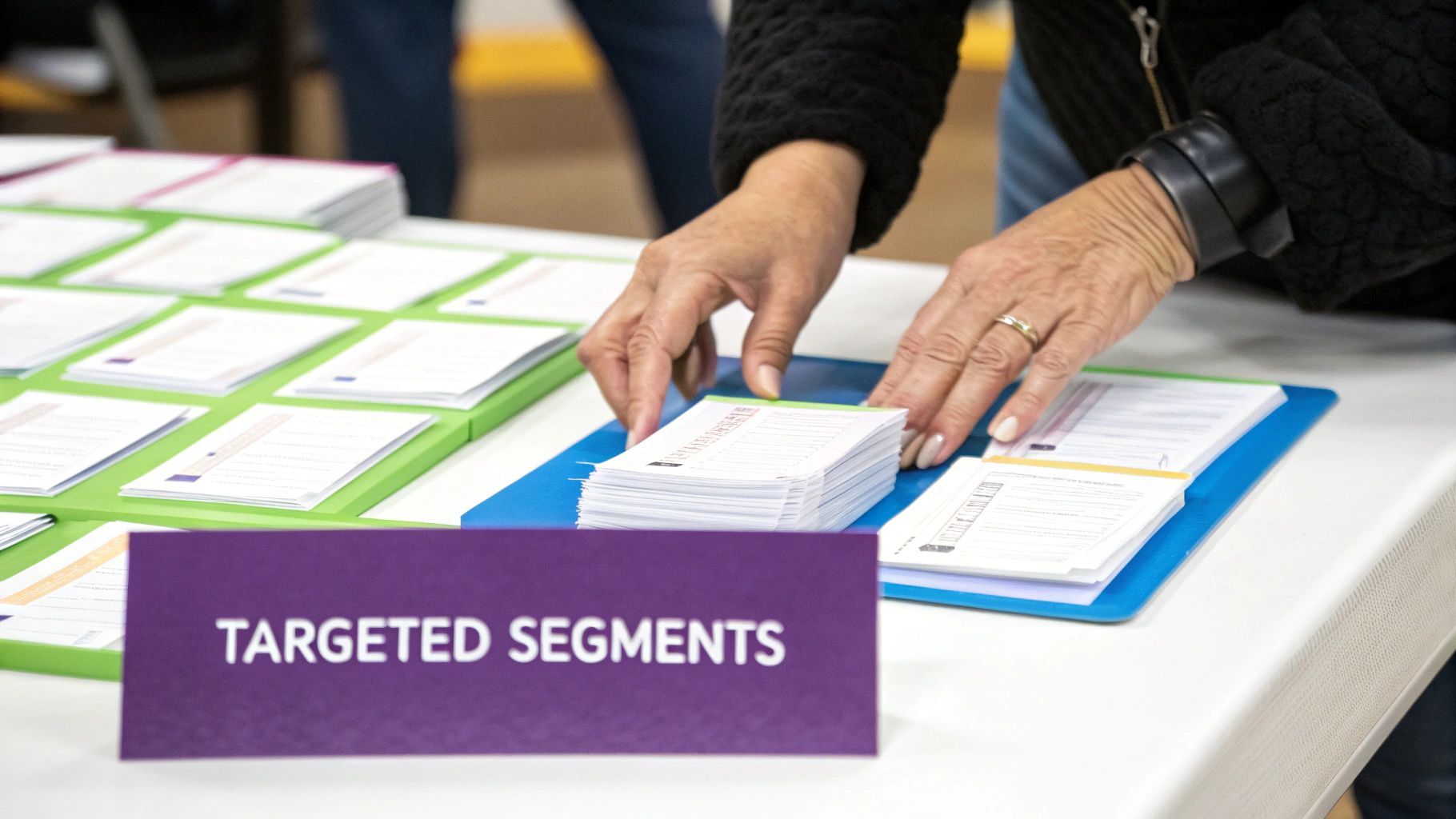
You've done the hard work. Your lead list is clean, enriched, and segmented with precision. What you're holding isn't just a spreadsheet anymore; it's a curated list of genuine opportunities. Now for the fun part: engaging these prospects in a way that actually gets their attention.
The secret is to think beyond a single channel. Relying only on email is like trying to fish in a massive lake by only casting your line in one spot. To really make an impact, you need a modern multi-channel marketing strategy that reaches people where they're most active and builds trust over time.
Choosing Your Core Outreach Channels
Different channels have different strengths. The magic happens when you blend them together to create a cohesive journey for your prospect, where each touchpoint builds on the last. Let's break down the heavy hitters.
1. Email: The Workhorse of B2B Outreach
Email is still the backbone of most campaigns for a reason. It’s direct, professional, and perfect for sharing detailed, personalized messages—think valuable content, case studies, or specific proposals. Plus, it's incredibly easy to scale with the right automation tools.
2. LinkedIn: The Professional's Social Hub
LinkedIn is so much more than a place to send connection requests. It's where you warm up your leads before you ever hit their inbox. You can engage with their posts, send a quick, conversational InMail, or just use it as a low-pressure first touch. That profile data you extracted with ProfileSpider—like their current role or recent activity—is absolute gold here.
3. Targeted Ads: The "Stay Top-of-Mind" Tool
This is a pro move. Take your segmented list and upload it as a custom audience on platforms like LinkedIn or Facebook. This lets you run highly targeted ads that keep your brand in front of key accounts. It's a subtle but powerful way to build brand recognition, so when your email or InMail finally does arrive, your name already looks familiar.
Building a Cohesive Outreach Sequence
A real multi-channel sequence isn't just blasting messages everywhere at once. It’s a carefully choreographed dance of interactions designed to build a genuine connection.
Here’s what that looks like in the real world for a high-value prospect:
- Day 1: Simply view their LinkedIn profile. It’s a small, passive action that often sparks curiosity and puts you on their radar.
- Day 2: Send a personalized LinkedIn connection request. Skip the generic template. Mention a mutual connection, a recent article they shared, or their company's latest milestone.
- Day 4: Now, send your first email. You can reference your new LinkedIn connection and then get straight to the point with a clear value proposition tailored to their specific industry or role.
- Day 7: Go engage with their content on LinkedIn again. A thoughtful comment on something they posted shows you're paying attention and not just another bot.
- Day 10: Send a brief follow-up email. This one can be shorter, maybe sharing a relevant case study or a quick tip related to a common pain point in their field.
This multi-touch approach makes your outreach feel human, not transactional. Each step is a small investment in building rapport.
The goal of a multi-channel campaign isn't to bombard your prospects. It's to create a persistent, gentle presence that positions you as a helpful resource, not an annoying interruption.
Why This Approach Works So Well
The effectiveness of your lead list skyrockets when you combine channels intelligently. For example, content marketing delivers three times more leads at a 62% lower cost than old-school outbound methods. It's no surprise that 89.2% of B2B marketers use blogs to attract leads, while 69.2% lean on email to nurture them. This shows that a blended strategy is what truly moves the needle.
By creating a sequence that spans multiple platforms, you cater to different communication preferences and dramatically increase your chances of getting noticed. For a deeper dive, check out our guide on 10 proven lead generation best practices you can start using today at https://profilespider.com/blog/10-proven-lead-generation-best-practices.
Using Automation to Scale Your Outreach
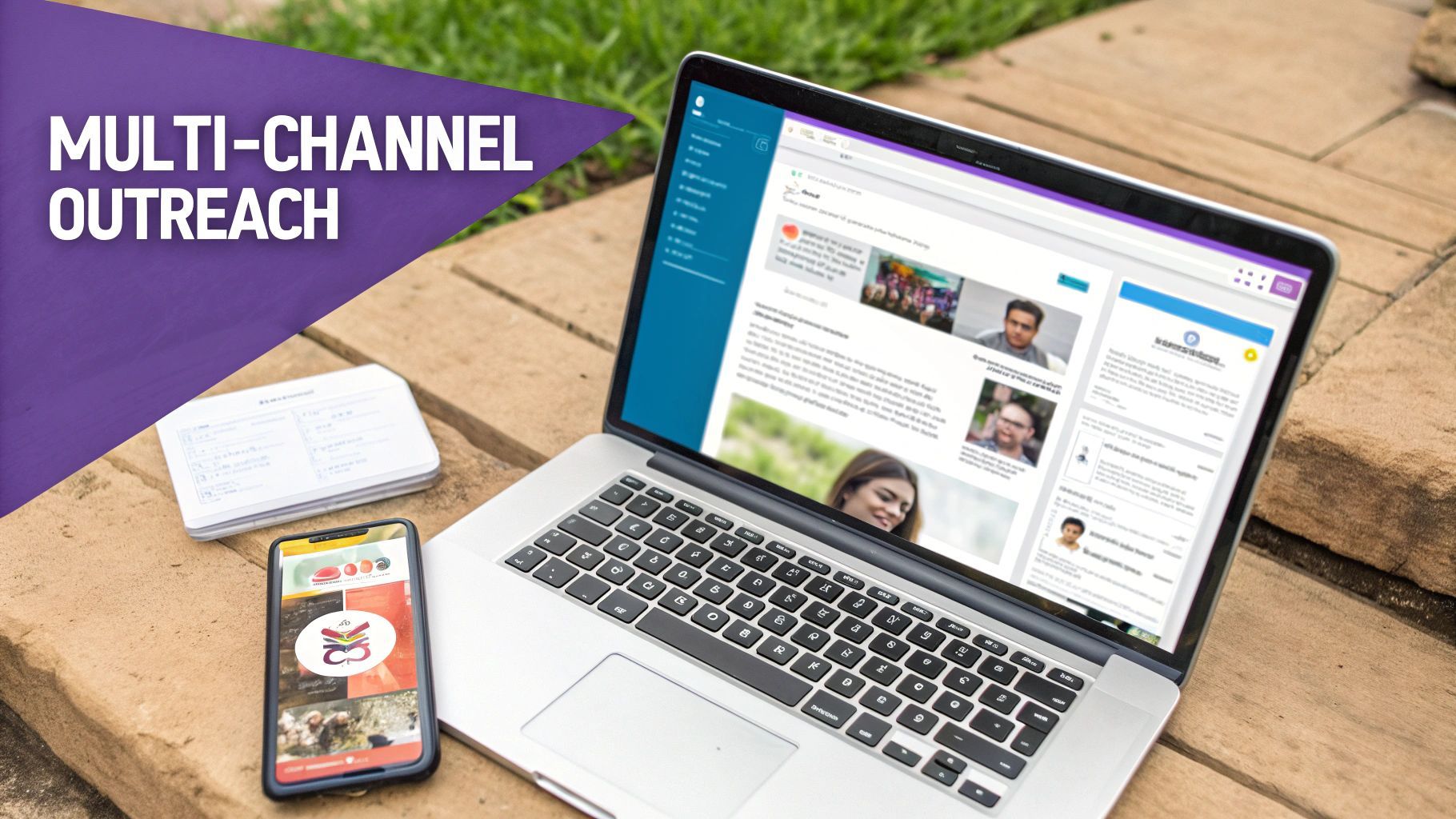
Personalized outreach is a game-changer, but it has a massive weakness—it doesn't scale. You can't possibly sit there and hand-craft emails for hundreds of prospects. It's not just impractical; it's a fast track to burning out. This is exactly where technology steps in to become your best friend.
Automation is what lets you keep that personal touch while reaching a much bigger audience. It takes care of all the repetitive, time-consuming tasks, which frees you up to focus on the big-picture strategy and have real conversations with people who are actually interested.
From ProfileSpider to Your Outreach Engine
Your automation journey kicks off the second you have your lead list finalized. Using a tool like ProfileSpider, you’ve already done the hard work of finding and enriching your contacts. Now, it’s time to unleash that data.
One of the simplest, most effective moves is to export your cleaned and segmented lists directly from ProfileSpider. With a single click, you can generate a CSV, Excel, or JSON file that’s ready to be imported into just about any CRM or outreach tool out there. This handoff is the crucial link between collecting data and actually engaging with it at scale.
Building Your Automated Outreach Stack
With your list in hand, you need the right tools to get your campaigns off the ground. Your "tech stack" doesn't need to be some complicated beast; it just needs to work. The goal here is to automate sequences across your main channels, which are typically email and LinkedIn.
Here are a few popular platforms people use for this:
- Email Sequencing Tools: Services like Mailshake, Lemlist, or Woodpecker are built specifically for cold outreach. They let you create multi-step email campaigns that automatically follow up with anyone who doesn't reply.
- LinkedIn Automation Tools: These tools can handle tasks like sending connection requests or follow-up messages on LinkedIn, giving you a second touchpoint to complement your emails.
The real magic happens when you build smart sequences that react to what your prospects do. For example, you can set a rule to immediately stop the sequence if someone replies. Or, you could trigger a unique follow-up if they click a link in your email. This makes your automation feel responsive and human, not like a mindless robot.
Personalization at Scale
Here’s the thing: automation without personalization is just fancy spam. The whole point is to use the amazing data you've gathered to make every message feel like it was written just for them. The secret weapon for this is using dynamic fields (sometimes called merge tags).
Instead of a generic "Hello," your email can start with "Hi {first_name}." But you can, and should, go deeper. With the data you exported from ProfileSpider, you can drop in their {job_title}, {company_name}, or even mention their {industry} to make the message incredibly relevant. This isn't just a neat trick; it's fundamental to getting results.
We all know generating leads is tough, but the real battle is often in the follow-up. Research shows that since 96.45% of website visitors aren't ready to buy on their first visit, a solid nurturing process is non-negotiable. That's why 50% of companies are planning to invest more in automation platforms—they know it’s the key to turning prospects into customers.
To really dial up your efficiency, think about weaving different AI marketing tools into your process. When you build a smart tech stack, you're not just sending emails; you're turning a static list into a dynamic outreach machine that ensures no lead ever gets left behind.
For some hands-on ideas, you might want to check out our article on different marketing automation workflow examples.
https://profilespider.com/blog/marketing-automation-workflow-examples
Measuring Success and Optimizing Your Strategy
Let's be real: launching your campaign is just the starting line. Effective lead list marketing isn’t a “set it and forget it” game. The real growth happens when you start paying close attention to the data, figuring out what it’s telling you, and making smart adjustments on the fly.
Without tracking, you’re just guessing. With tracking, you’re building a repeatable engine for success.
The whole point is to create a feedback loop. You send a campaign, measure what happens, learn from what worked (and what flopped), and then pour those insights right back into your next round. Each cycle makes your outreach sharper, more relevant, and a whole lot more effective.
Defining Your Key Performance Indicators
Before you can start tweaking things, you have to know what to measure. Staring at a dashboard full of numbers is useless if you don't know which ones actually matter. You need to zero in on the key performance indicators (KPIs) that directly tell you how your campaign is doing and whether it's hitting your goals.
These are the core metrics you absolutely have to watch:
- Email Open Rate: This is your first hurdle. If this number is low, it’s a big red flag for a weak subject line, a stale list, or deliverability problems.
- Reply Rate: I’d argue this is even more important than the open rate. This number tells you if your message actually resonated enough to get someone to hit "reply."
- Click-Through Rate (CTR): If you included a link to a case study, your website, or a demo, the CTR shows how many people were intrigued enough to take that next step.
- Meetings Booked: For any sales team, this is where the rubber meets the road. It’s the metric that shows your outreach is turning into actual sales conversations.
- Conversion Rate: This is the ultimate bottom line. It tracks how many leads took the final action you wanted, whether that's buying something, starting a trial, or becoming a qualified lead.
A high open rate with a low reply rate tells a very specific story. It means your subject line did its job and got their attention, but the body of your message completely missed the mark.
Using A/B Testing to Find What Works
Making decisions based on data means you have to challenge your assumptions. A/B testing is a beautifully simple—and powerful—way to do just that. The concept is straightforward: you create two versions of a single element (like a subject line), send each version to a small, random chunk of your list, and see which one wins.
Whichever version performs better gets rolled out to the rest of your list. Simple as that.
Simple A/B Tests You Can Run Right Now:
- Subject Lines: Pit a personalized subject line ("Question for [Company Name]") against a benefit-driven one ("Saving 10 hours a week on [Task]").
- Calls-to-Action (CTAs): Test a hard CTA ("Book a demo now") against a softer, more exploratory one ("Interested in learning more?").
- Email Body Length: See what happens when you compare a short, punchy email to a longer, more detailed one that's packed with value.
By constantly testing, you stop guessing and start building a proven strategy. Over time, these small optimizations really add up, leading to massive improvements in your campaign's performance. It’s this iterative process that separates the campaigns that fizzle out from the ones that drive real, long-term results.
Even with a solid playbook, you're bound to run into some tricky situations when marketing a new lead list. It happens to everyone. Navigating the gray areas of outreach frequency, legal rules, and technical gremlins is what separates a one-off campaign from a long-term pipeline builder.
Let's tackle some of the most common questions that pop up for recruiters, salespeople, and marketers in the trenches.
How Often Should I Contact My Leads?
This is the million-dollar question, isn't it? Finding that perfect rhythm between being persistent and just being annoying is a real balancing act. There's no magic number here—the right cadence really depends on your industry, who you're talking to (a C-suite exec vs. a manager), and how compelling your offer is.
A good place to start for any cold outreach sequence is somewhere in the range of 3-5 touches over 2-4 weeks. This gives you a few shots at connecting without completely flooding their inbox.
But here’s the key: every single touchpoint needs to add value. Don't just "check in." Share a relevant case study, point them to a useful blog post, or offer a unique insight you found about their company. Keep a close eye on your engagement metrics. If you see unsubscribe rates jumping, you're pushing too hard. If engagement is dead, you might need a more assertive approach or, more likely, a much stronger message.
What Are the Biggest Legal Risks to Know?
Data privacy and anti-spam laws are the two big legal minefields you absolutely have to navigate carefully. Regulations like GDPR in Europe and CAN-SPAM in the U.S. are no joke—they lay out strict rules for sending commercial messages. Ignoring them can lead to some seriously hefty fines and, just as bad, a trashed brand reputation.
Here's your compliance checklist:
- A Legitimate Reason to Reach Out: You need a valid basis for contact. In B2B, this often falls under "legitimate interest," but you need to be able to justify it.
- A Clear Way Out: Every single message must have an easy-to-find, one-click way for people to unsubscribe. No exceptions.
- Be Transparent: Be crystal clear about who you are and why you're in their inbox. Don't ever use deceptive subject lines or "from" names.
A tool like ProfileSpider gives you total control by storing all the data you extract locally in your browser. This privacy-first approach means no data is sent to external servers without your consent. But with great power comes great responsibility. You are always the one accountable for using that data ethically and in full compliance with the law.
Why Are My Email Open Rates So Low?
Low open rates are a huge bummer, but they almost always point back to one of three culprits.
First up is deliverability. It's possible your emails aren't even making it to the inbox and are getting flagged as spam. The fix here is to warm up your email account properly using a service designed for it and to make sure your domain's SPF and DKIM records are set up correctly. This tells email providers you're a legitimate sender.
Second, it could be your subject line. Let's be honest, is it compelling enough to stand out in an inbox overflowing with noise? You have to A/B test different angles. Try personalizing it, asking a question that sparks curiosity, or leading with a clear benefit.
And third—the most common reason by far—is poor list quality. Your data might just be old, stale, or flat-out wrong. Regularly cleaning your list with an email validation service isn't just a "nice to have," it's absolutely essential for making sure you're actually sending emails to real, active people.

